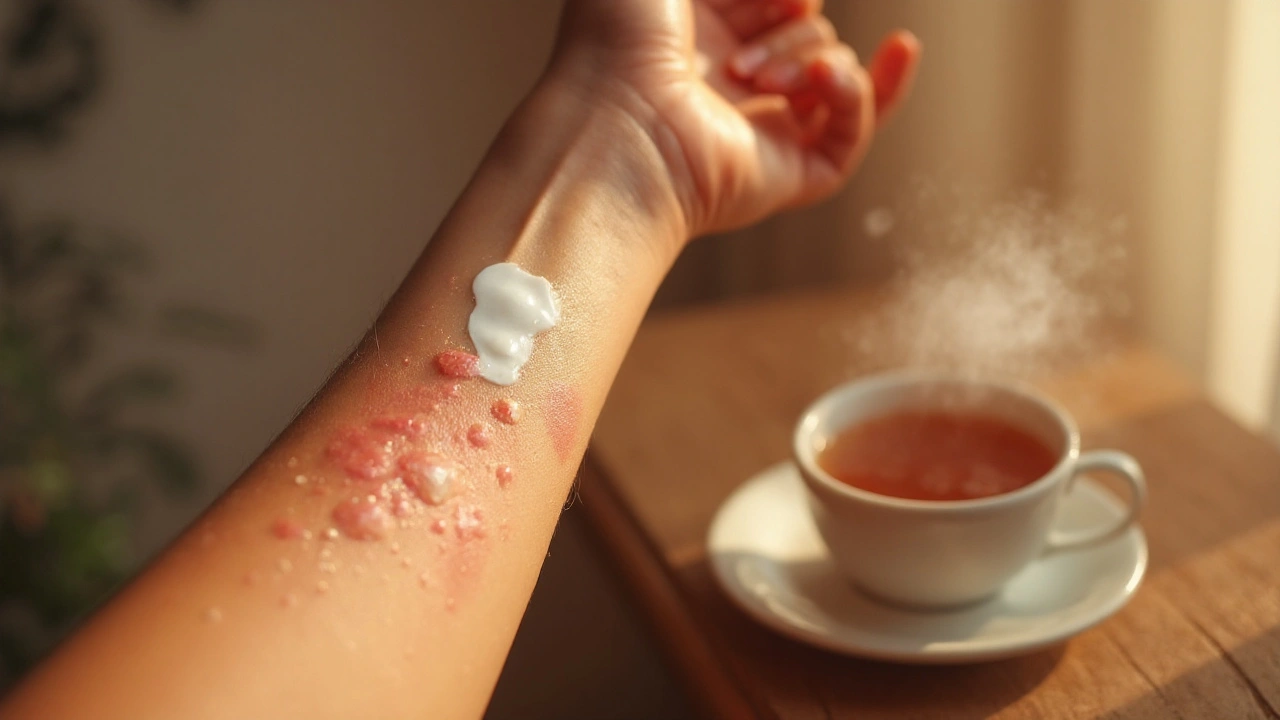Eczema is a chronic inflammatory skin condition that manifests as red, itchy patches and, crucially, can produce intense skin pain. When the skin barrier breaks down, nerves become exposed, turning a simple itch into a burning or stinging sensation.
Quick Takeaways
- Eczema pain stems from barrier disruption, inflammation and nerve sensitisation.
- Identify triggers - soaps, fabrics, stress or temperature changes - before they flare.
- Daily moisturising, gentle cleansing and short‑term steroids are the backbone of relief.
- Advanced options such as phototherapy or biologics help when standard care fails.
- Seek professional advice if pain worsens, spreads rapidly or is accompanied by fever.
Understanding Eczema and Why It Hurts
At its core, eczema (also known as Atopic Dermatitis is a genetically‑linked, immune‑driven skin disease) weakens the skin’s protective barrier. This barrier normally traps moisture and blocks irritants. When it’s compromised, moisture evaporates, allergens slip in and inflammatory chemicals like histamine flood the area. Those chemicals activate tiny nerve endings, turning an itch into a painful burn.
Another common variant, Contact Dermatitis is a reaction to direct contact with an irritant or allergen, can produce a similar pain profile, often overlapping with eczema in the same skin region.
What Triggers Skin Pain in Eczema?
- Environmental irritants: harsh soaps, detergents, low‑humidity air.
- Physical factors: rough fabrics (wool), excessive scratching, heat.
- Allergic reactions: nickel, fragrance, certain foods.
- Microbial imbalance: overgrowth of Staphylococcus aureus is a common skin bacterium that can exacerbate inflammation.
- Stress: amplifies immune response, making pain feel sharper.
When any of these agents breach the weakened barrier, they trigger an inflammatory cascade that heightens nerve sensitivity - the root of that sharp, stinging pain many describe.
Diagnosing Eczema‑Related Pain
Doctors start with a visual exam, looking for the classic eczema distribution (flexural creases, neck, hands). They may ask for a Allergy Test is a blood or skin‑prick test that identifies specific allergens if contact dermatitis is suspected. In ambiguous cases, a skin biopsy can rule out psoriasis or seborrheic dermatitis.
Key diagnostic clues for pain‑focused eczema include:
- Visible rash with dry, cracked skin.
- History of recurring flares linked to triggers.
- Reports of burning, stinging or throbbing sensations rather than pure itch.
- Absence of systemic symptoms like fever (unless infection is present).

Everyday Strategies to Calm the Pain
Consistent skin‑care is the first line of defence. Below is a simple routine you can adopt:
- Gentle cleansing: Use a fragrance‑free, sulfate‑free cleanser. Limit showers to 5‑10minutes with lukewarm water.
- Pat‑dry, don’t rub: Rubbing can further damage the barrier and aggravate nerves.
- Lock‑in moisture: Within three minutes, apply a Moisturizer is a lipid‑rich cream or ointment designed to restore the skin barrier containing ceramides, hyaluronic acid and glycerin.
- Targeted relief: For active flare‑ups, thin a Topical Steroid is a corticosteroid cream that reduces inflammation quickly (e.g., 1% hydrocortisone) onto the painful spots for up to 7 days.
- Cool compresses: A clean, damp cloth for 10minutes can soothe burning sensations.
- Protective clothing: Choose soft, breathable fabrics like cotton; avoid wool or synthetic blends that can rub.
Remember, the goal is to keep the skin barrier intact and calm the nerves before the pain spirals.
Medical Treatments - What Works Best?
| Treatment | Mechanism | Typical Use | Side‑effects | Cost (UK) |
|---|---|---|---|---|
| Moisturizer | Restores lipid barrier | Daily, all stages | Rare irritation | £5‑£15 per tube |
| Topical Steroid | Suppresses inflammation | Flare‑up periods (1‑2weeks) | Skin thinning, stretch marks | £3‑£10 per tube |
| Phototherapy (NB‑UVB) | Modulates immune response | 2‑3 sessions/week, 8‑12weeks | Redness, rare burns | £150‑£400 total |
| Dupilumab | Blocks IL‑4/IL‑13 signalling | Moderate‑to‑severe, systemic | Conjunctivitis, injection site pain | £800‑£1,200 per month |
For most people, a layered approach - moisturiser + occasional steroid - covers the majority of pain episodes. If you find yourself needing steroids more than twice a month, it’s time to discuss phototherapy or biologic options like Dupilumab is a monoclonal antibody approved for moderate‑to‑severe atopic dermatitis.
Lifestyle Tweaks That Lower Pain Triggers
- Humidity control: Use a humidifier in winter to keep skin from drying out.
- Stress management: Mindfulness, yoga or short walks can blunt the stress‑inflamed pain pathway.
- Dietary watch: Some patients notice improvement by limiting high‑histamine foods such as aged cheese, wine and smoked meats.
- Regular skin checks: Early spotting of infection (pus, crust) prevents painful worsening.
- Avoid scratching: Keep nails trimmed; use a cool gel pad instead of a fingernail when urge strikes.
When to Seek Professional Help
If any of the following occur, book a dermatologist promptly:
- Pain spreads rapidly or is accompanied by swelling.
- Signs of infection - yellow crusts, fever, foul odour.
- Traditional topical therapy fails after two weeks.
- You need a prescription-strength steroid or biologic.
Early intervention can stop a painful flare from becoming chronic, protecting both skin health and quality of life.

Frequently Asked Questions
Can eczema cause constant pain, not just occasional flare‑ups?
Yes. When the barrier remains compromised for weeks, nerve endings stay sensitised, leading to a lingering, throbbing ache even without visible redness. Restoring the barrier with moisturiser and addressing inflammation is essential.
Is it safe to use over‑the‑counter hydrocortisone every day?
Short‑term use (up to two weeks) is generally safe for mild flares. Daily long‑term use can thin the skin and worsen pain. Rotate with a plain moisturiser and consult a doctor if you need steroids more than twice a month.
Do diet changes really help eczema pain?
For a subset of patients, high‑histamine foods can amplify inflammation, making pain feel sharper. Keeping a food‑symptom diary for four weeks often reveals personal triggers, which you can then avoid.
How does phototherapy reduce the feeling of pain?
Narrow‑band UVB light slows the overactive immune cells that release pain‑inducing cytokines. After a series of sessions, many report smoother skin and a noticeable drop in burning sensations.
Is Dupilumab only for severe cases?
Dupilumab is approved for moderate‑to‑severe atopic dermatitis, especially when topical therapies and phototherapy haven’t given lasting relief. Because it targets specific immune pathways, it often eliminates both itch and associated pain.


Comments (16)
Zac James
September 25, 2025 AT 22:12Swap your regular body wash for a fragrance‑free, sulfate‑free cleanser. This simple change reduces barrier irritation and lets your skin breathe. After showering, apply a lipid‑rich moisturizer while the skin is still damp to lock in moisture.
Arthur Verdier
September 29, 2025 AT 09:24Funny how the big pharma giants keep pushing expensive biologics while a cheap over‑the‑counter steroid could do the trick if you just read the fine print. They don’t want you to discover that most of the “miracle” creams are just fancy moisturizers with a dash of steroid. So, keep your eyes peeled for the hidden marketing ploys.
Breanna Mitchell
October 2, 2025 AT 20:36Remember, every small step counts. Even a five‑minute lukewarm shower followed by a quick pat‑dry instead of rubbing can make a difference. Keeping your nails trimmed and using a soft cotton glove when the itch hits helps prevent the skin from further damage.
Alice Witland
October 6, 2025 AT 07:48While you’re busy unmasking conspiracies, the skin still needs proper care. A gentle, fragrance‑free cleanser and consistent moisturising are non‑negotiable, regardless of any “secret agenda” you suspect.
Chris Wiseman
October 9, 2025 AT 19:00One might contemplate the very nature of pain as an epistemic signal, a messenger dispatched by the integumentary system to declare betrayal by its own barrier. When the lipid matrix fragments, the epidermal nerves, previously insulated, become unshielded, transmitting electrical discharges that our brain interprets as burning. This biochemical symphony is orchestrated by cytokines, histamine, and interleukins, each contributing its own timbre to the overall cacophony of discomfort. The philosophical implication is that pain, though unwelcome, is an honest narrator of physiological disarray. Therefore, to silence the narrator, one must address the root cause rather than merely silencing the voice. Restoring the barrier, through ceramide‑rich emollients, reestablishes the fortress that keeps nociceptors at bay. Concurrently, judicious use of topical corticosteroids dampens the inflammatory chorus, allowing the skin’s reparative processes to resume undisturbed. Moreover, the environment-temperature fluctuations, low humidity, abrasive fabrics-acts as an external antagonist, provoking the skin’s defensive mechanisms. By regulating indoor humidity and opting for breathable cotton garments, one removes these provocateurs from the stage. Dietary considerations, though often dismissed, can modulate systemic inflammation; a reduction in high‑histamine foods may soften the intensity of the neural signals. Stress, the ubiquitous unseen puppeteer, amplifies the entire performance, heightening perception of pain through cortisol‑mediated pathways. Integrating mindfulness practices can therefore serve as a backstage manager, dimming the lights on stress‑induced amplification. Phototherapy, while seemingly high‑tech, works by recalibrating the immune cells, offering a reprieve from chronic pain for those who have exhausted topical measures. Finally, emergent biologics such as dupilumab target specific interleukin pathways, providing a surgical strike against the inflammatory cascade. In essence, a multi‑pronged strategy-barrier repair, anti‑inflammatory agents, lifestyle modifications, and advanced therapeutics-constitutes the most rational approach to taming eczema‑induced pain.
alan garcia petra
October 13, 2025 AT 06:12A cool compress for ten minutes works wonders.
Allan Jovero
October 16, 2025 AT 17:24It is imperative to employ the correct orthography: “moisturiser” rather than “moisturizer” when adhering to British English conventions, particularly in a medical context.
Andy V
October 20, 2025 AT 04:36While your dedication to spelling is noted, the substantive issue remains-using a fragrance‑free, ceramide‑rich product is far more critical than any lexical preference.
Tammie Sinnott
October 23, 2025 AT 15:48Behold, the hidden culprits: aged cheeses, red wine, and smoked meats, each a treacherous herald of histamine that can inflame the skin’s already fragile citadel. By charting a four‑week food diary, you may uncover the poisonous allies that exacerbate your eczema pain.
Michelle Wigdorovitz
October 27, 2025 AT 03:00Indeed, the diary becomes a chronicle of betrayal, revealing the silent saboteurs that lurk within our plates. Armed with this knowledge, you can orchestrate a culinary exodus, sparing your skin from further onslaught.
Arianne Gatchalian
October 30, 2025 AT 14:12I’ve seen many people feel isolated by chronic skin pain, but sharing your experiences with a supportive community can lighten the emotional load. Remember, you’re not alone, and together we can navigate these flare‑ups.
Sen Đá
November 3, 2025 AT 01:24In accordance with dermatological best practices, any indication of secondary infection-such as erythema accompanied by purulent exudate-necessitates immediate consultation with a qualified physician to prevent systemic complications.
LEE DM
November 6, 2025 AT 12:36Balancing daily moisturisation with short‑term steroid bursts usually covers most mild to moderate flares; consider phototherapy only if symptoms persist beyond two weeks.
mathokozo mbuzi
November 9, 2025 AT 23:48May I inquire whether you have explored the utility of emollient‑enhanced barrier repair protocols, which have demonstrated efficacy in reducing transepidermal water loss among atopic populations?
Penny X
November 13, 2025 AT 11:00It is a matter of ethical responsibility that healthcare providers disseminate accurate information regarding eczema management, lest patients be misled by unsubstantiated remedies and suffer needless discomfort.
Amy Aims
November 16, 2025 AT 22:12Absolutely, clear guidance saves everyone! 😊 Keep the conversation going and share what works for you.